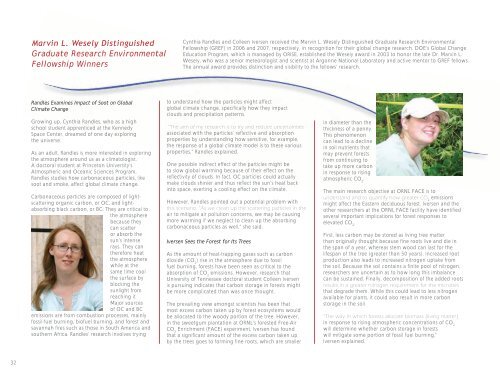2007 ORAU Annual Report - Oak Ridge Associated Universities
2007 ORAU Annual Report - Oak Ridge Associated Universities
2007 ORAU Annual Report - Oak Ridge Associated Universities
Create successful ePaper yourself
Turn your PDF publications into a flip-book with our unique Google optimized e-Paper software.
Marvin L. Wesely Distinguished<br />
Graduate Research Environmental<br />
Fellowship Winners<br />
Cynthia Randles and Colleen Iversen received the Marvin L. Wesely Distinguished Graduate Research Environmental<br />
Fellowship (GREF) in 2006 and <strong>2007</strong>, respectively, in recognition for their global change research. DOE’s Global Change<br />
Education Program, which is managed by ORISE, established the Wesely award in 2003 to honor the late Dr. Marvin L.<br />
Wesely, who was a senior meteorologist and scientist at Argonne National Laboratory and active mentor to GREF fellows.<br />
The annual award provides distinction and visibility to the fellows’ research.<br />
Randles Examines Impact of Soot on Global<br />
Climate Change<br />
Growing up, Cynthia Randles, who as a high<br />
school student apprenticed at the Kennedy<br />
Space Center, dreamed of one day exploring<br />
the universe.<br />
As an adult, Randles is more interested in exploring<br />
the atmosphere around us as a climatologist.<br />
A doctoral student at Princeton University’s<br />
Atmospheric and Oceanic Sciences Program,<br />
Randles studies how carbonaceous particles, like<br />
soot and smoke, affect global climate change.<br />
Carbonaceous particles are composed of lightscattering<br />
organic carbon, or OC, and lightabsorbing<br />
black carbon, or BC. They are critical to<br />
the atmosphere<br />
because they<br />
can scatter<br />
or absorb the<br />
sun’s intense<br />
rays. They can<br />
therefore heat<br />
the atmosphere<br />
while at the<br />
same time cool<br />
the surface by<br />
blocking the<br />
sunlight from<br />
reaching it.<br />
Major sources<br />
of OC and BC<br />
emissions are from combustion processes, mainly<br />
fossil-fuel burning, biofuel burning, and forest and<br />
savannah fires such as those in South America and<br />
southern Africa. Randles’ research involves trying<br />
to understand how the particles might affect<br />
global climate change, specifically how they impact<br />
clouds and precipitation patterns.<br />
“The aim of my research is to try and reduce uncertainties<br />
associated with the particles’ reflective and absorption<br />
properties by understanding how sensitive, for example,<br />
the response of a global climate model is to these various<br />
properties,” Randles explained.<br />
One possible indirect effect of the particles might be<br />
to slow global warming because of their effect on the<br />
reflectivity of clouds. In fact, OC particles could actually<br />
make clouds shinier and thus reflect the sun’s heat back<br />
into space, exerting a cooling effect on the climate.<br />
However, Randles pointed out a potential problem with<br />
this scenario. “As we clean up the scattering particles in the<br />
air to mitigate air pollution concerns, we may be causing<br />
more warming if we neglect to clean up the absorbing<br />
carbonaceous particles as well,” she said.<br />
Iversen Sees the Forest for Its Trees<br />
As the amount of heat-trapping gases such as carbon<br />
dioxide (CO 2<br />
) rise in the atmosphere due to fossil<br />
fuel burning, forests have been seen as critical to the<br />
absorption of CO 2<br />
emissions. However, research that<br />
University of Tennessee doctoral student Colleen Iversen<br />
is pursuing indicates that carbon storage in forests might<br />
be more complicated than was once thought.<br />
The prevailing view amongst scientists has been that<br />
most excess carbon taken up by forest ecosystems would<br />
be allocated to the woody portion of the tree. However,<br />
in the sweetgum plantation at ORNL’s forested Free-Air<br />
CO 2<br />
Enrichment (FACE) experiment, Iversen has found<br />
that a significant amount of the excess carbon taken up<br />
by the trees goes to forming fine roots, which are smaller<br />
in diameter than the<br />
thickness of a penny.<br />
This phenomenon<br />
can lead to a decline<br />
in soil nutrients that<br />
may prevent forests<br />
from continuing to<br />
take up more carbon<br />
in response to rising<br />
atmospheric CO 2<br />
.<br />
The main research objective at ORNL FACE is to<br />
understand and to quantify how greater CO 2<br />
emissions<br />
might affect the Eastern deciduous forest. Iversen and the<br />
other researchers at the ORNL FACE facility have identified<br />
several important implications for forest responses to<br />
elevated CO 2<br />
.<br />
First, less carbon may be stored as living tree matter<br />
than originally thought because fine roots live and die in<br />
the span of a year, whereas stem wood can last for the<br />
lifespan of the tree (greater than 50 years). Increased root<br />
production also leads to increased nitrogen uptake from<br />
the soil. Because the soil contains a finite pool of nitrogen,<br />
researchers are uncertain as to how long this imbalance<br />
can be sustained. Finally, decomposition of the added roots<br />
results in a greater nitrogen requirement for the microbes<br />
that degrade them. While this could lead to less nitrogen<br />
available for plants, it could also result in more carbon<br />
storage in the soil.<br />
“The way in which forests allocate biomass [living matter]<br />
in response to rising atmospheric concentrations of CO 2<br />
will determine whether carbon storage in forests<br />
will mitigate some portion of fossil fuel burning,”<br />
Iversen explained.<br />
32

















